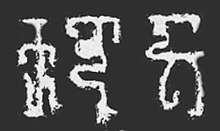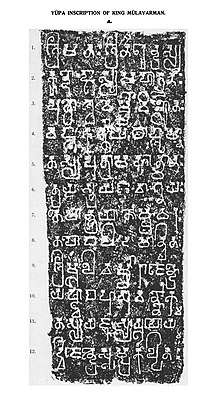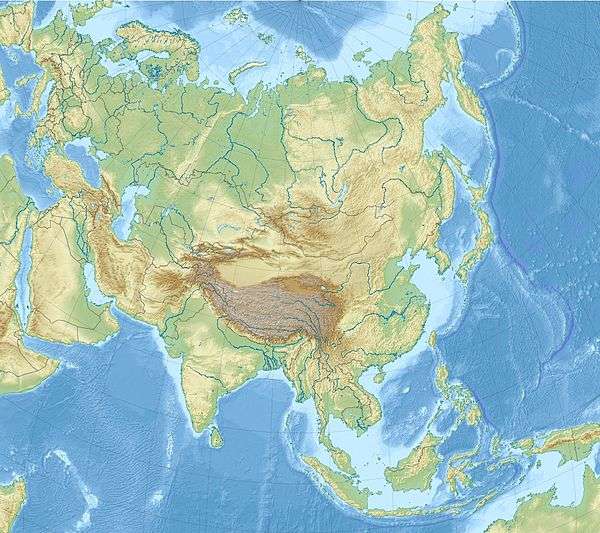Kudungga
Kudungga (Ku-ṇḍu-ṅga) was the founder of the kingdom Kutai Martadipura with the title of Maharaja Kudungga Anumerta Devavarman, who ruled around the year 350 AD or 4th century AD. Kutai Martadipura led by Kudungga was not yet serves as a king, but as a community leader or chieftain.[2] Kutai Martadipura during Kudungga rule do not have a regular and systematical system of governance.[3] In contrary, the latest claim is said that Maharaja Kudungga is possibly a king from ancient kingdom Bakulapura in Tebalrung (now Tebalai Indah, Muara Kaman), and Asvavarman which his son-in-law rather his son, then become the first king of Kutai Martadipura.[4]


History
The discovery of the most reliable source stating that Kutai Martadipura is the oldest kingdom in the nusantara archipelago is in yupa inscriptions.[5] Seven pieces of yupa were found in Muara Kaman.[5] According to the results of a study conducted by J.G. de Casparis (1949), yupa-yupa in Muara Kaman which allegedly a Kutai Martadipura civilization heritage were found successively in 1879 and 1940.[5]
In yupa-yupa, found there are inscriptions using Pallawa script in Sanskrit language. Letters engraved on yupa thought to have come from the end of the 4th century or early 5th century AD. All the monument stone was issued at the command of a leader named Maharaja Mulavarman Naladewa.[6] Mulavarman allegedly are Indianize name of indigenous people because the name of his grandfather, namely Kudungga (there is also a mention kudunga or kundungga) is the original name of the indigenous Indonesian.[6] Kudungga is what is believed to be the forerunner of the first leader of the kingdom of Kutai Martadipura, while Mulavarman is the successor Asvavarman (son of Kudungga) which brings the kingdom of Kutai Martadipura at the glory.[6]
R.M. Ng. Poerbatjaraka (1952) interpret the circuit Pallava inscriptions in Sanskrit recorded on yupa about the genealogy of the kings who had ruled in the early days of the kingdom of Kutai Martadipura in translation:[7]
śrīmatah śrī-narendrasya; kuṇḍuṅgasya mahātmanaḥ; putro śvavarmmo vikhyātah; vaṅśakarttā yathāṅśumān; tasya putrā mahātmānaḥ; trayas traya ivāgnayaḥ; teṣān trayāṇām pravaraḥ; tapo-bala-damānvitaḥ; śrī mūlavarmmā rājendro; yaṣṭvā bahusuvarṇnakam; tasya yajñasya yūpo ‘yam; dvijendrais samprakalpitaḥ.
Translation:
Mahārāja (emperor) Kundungga, most noble, has a famous son, his name Aśwawarmman, who like Angśuman (the Sun God) cultivates a very noble family. The Aśwawarmman has three sons, like (sacred) fire. The prominent of the three sons is the Mūlawarmman, a king of good civil, strong and might. The Mūlawarmman held kenduri (salvation ceremony) with gold-very-much. For the memorial kenduri (salvation ceremony) that stone pillar was founded by the brahmanas.
From inscription of heritage above can be concluded that the first king of Kutai Martadipura, is Kudungga. Kudungga has a son named Asvavarman who then pass the leadership in the kingdom of Kutai. Asvavarman have three children's. Of the three children's Aswawarman have, there is a child who is the most prominent, a child name is Mulavarman as crown prince.[7]
Ancestry
Name Origin
The belief that Kudungga is indigenous Indonesian people based on the investigation that Kudungga clearly not Indian name, although the names of his descendants, Aswawarman and Mulawarman, containing elements of Indian name.[6] In this case. Poesponegoro and Notosusanto (1993) states that there is a name that is similar to Bugis, namely Kadungga.[6] The resemblance of this name is considered not just a coincidence given in South Sulawesi also found several inscriptions similar to what is found in Kutai.[6]
Poesponegoro and Notosusanto (1993) further concluded that the most likely, both Kudungga who named his son Asvavarman and Asvavarman himself named his son Mulavarman, eager to equate their degree and their descendant align with the knight caste as in India.[6] This possibility based on the fact that the word "varman" is derived from the Sanskrit word which is usually used to suffix the names of people in southern India.[3] In the Hindu tradition that comes from India, the social system of society is divided into classes, known as levels where the warrior caste or aristocratic kingdom included in a respectable caste.[6]
In this case. Poesponegoro and Notosusanto (1993) states there is a name that is similar to Bugis Kudungga mention, namely Kadungga.[6] The resemblance of this name is considered not just a coincidence given in South Sulawesi also found several inscriptions similar to what is found in Kutai.[6]
Poesponegoro and Notosusanto (1993) further concluded that the most likely, both Kudungga who named his son as well as Asvavarman and Asvavarman himself had a son named Mulawarman, eager to equate the degree they or their descendants in order to align with the knight at India.[6] This possibility based on the fact of the word "warman" is derived from the Sanskrit word which is usually used to suffix the names of people in southern India.[3] In the Hindu tradition that comes from India, the social system of society is divided into classes, known as levels where the warrior caste or aristocratic kingship included in nobleman caste.[3]
Latest Claim
The latest claim came from newly reestablished Kutai Mulawarman Kingdom (direct descendant of Sultanate of Kutai Kartanagara) in Indonesia, Maharaja Kudungga is a king of Bakulapura in Tabalrung. Kudungga is son of King Atwangga and King Atwangga is son of Mitrongga, which is descendant of Emperor Pushyamitra Shunga from Shunga Empire in Magadha, India.[4] In Maharaja Kudungga rule, Shunga Empire is no longer exist, and his successor Ashvavarman, use varman to state that his caste is kshatriya.
References
- VOGEL, J. Ph. (1918). "The Yupa Inscriptions of King Mulavarman, from Koetei (East Borneo)". Bijdragen tot de Taal-, Land- en Volkenkunde van Nederlandsch-Indië. 74 (1/2): 212. ISSN 1383-5408. JSTOR 20769898.
- Pustaka sekolah Archived 2015-04-19 at the Wayback Machine diakses 13 Maret 2015
- Melayu Online diakses 20 Februari 2015
- "Silsilah Kemashuran Sang Maharaja Kutai Mulawarman". Warta Ekspress. 2016. Retrieved 27 September 2017.
- Vogel, J.Ph., 1974.The Yupa Inscriptions of king Mulawarman from koetei (east borneo).BKI:Berlin
- Marwati Djoened Poesponegoro & nugroho notosusanto, 1993. Sejarah nasional Indonesia II. Balai pustaka:Jakarta
- R.M.Ng.Poerbatjaraka, 1952. Riwajat Indonesia I. Jajasan Pembangunan:Jakarta
